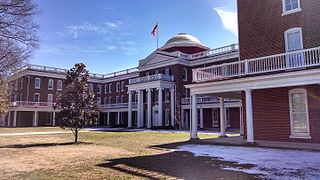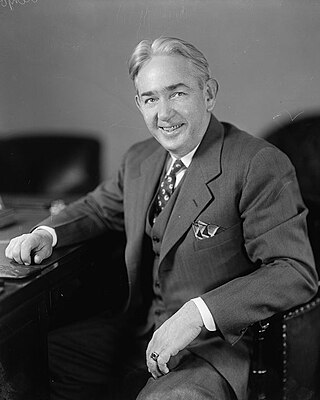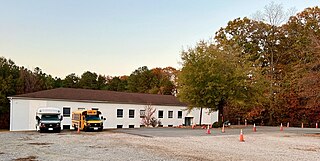School choice is a term for education options that allow students and families to select alternatives to public schools. It is the subject of fierce debate in various state legislatures across the United States.

Prince Edward County is located in the Commonwealth of Virginia. As of the 2020 census, the population was 21,849. Its county seat is Farmville.

John Singleton Mosby, also known by his nickname "Gray Ghost", was an American military officer who was a Confederate army cavalry battalion commander in the American Civil War. His command, the 43rd Battalion, Virginia Cavalry, known as Mosby's Rangers or Mosby's Raiders, was a partisan ranger unit noted for its lightning-quick raids and its ability to elude Union Army pursuers and disappear, blending in with local farmers and townsmen. The area of northern central Virginia in which Mosby operated with impunity became known as Mosby's Confederacy.

James Lindsay Almond Jr. was an American lawyer, state and federal judge and Democratic party politician. His political offices included as a member of the U.S. House of Representatives from Virginia's 6th congressional district (1946–1948), 26th Attorney General of Virginia (1948–1957) and the 58th Governor of Virginia (1958–1962). As a member of the Byrd Organization, Almond initially supported massive resistance to the integration of public schools following the United States Supreme Court decisions in Brown v. Board of Education, but when Virginia and federal courts ruled segregation unconstitutional, Almond worked with the legislature to end massive resistance.
Massive resistance was a strategy declared by U.S. senator Harry F. Byrd Sr. of Virginia and his son Harry Jr.'s brother-in-law, James M. Thomson, who represented Alexandria in the Virginia General Assembly, to get the state's white politicians to pass laws and policies to prevent public school desegregation, particularly after Brown v. Board of Education.

Segregation academies are private schools in the Southern United States that were founded in the mid-20th century by white parents to avoid having their children attend desegregated public schools. They were founded between 1954, when the U.S. Supreme Court ruled that segregated public schools were unconstitutional, and 1976, when the court ruled similarly about private schools.
Warren County High School (WCHS) is a high school located in Front Royal, Virginia. The mascot is a Wildcat and its colors are Maroon and White. Warren County competes in VHSL activities in the Evergreen District, Region II, Group AA. Its main rivals are Skyline High School and John Handley High School. For 67 years it was located on Luray Avenue. A new WCHS is located on Westminster Drive, serving the eastern 40% of the county.
John William Eggleston was a Virginia lawyer, politician and jurist whose tenure by the time of his death was the longest in the century.

The Robert Russa Moton Museum is a historic site and museum in Farmville, Prince Edward County, Virginia. It is located in the former Robert Russa Moton High School, considered "the student birthplace of America's Civil Rights Movement" for its initial student strike and ultimate role in the 1954 Brown v. Board of Education case desegregating public schools. It was designated a National Historic Landmark in 1998, and is now a museum dedicated to that history. In 2022 it was designated an affiliated area of Brown v. Board of Education National Historical Park. The museum were named for African-American educator Robert Russa Moton.
Griffin v. County School Board of Prince Edward County, 377 U.S. 218 (1964), is a case decided by the Supreme Court of the United States that held that the County School Board of Prince Edward County, Virginia's decision to close all local, public schools and provide vouchers to attend private schools were constitutionally impermissible as violations of the Equal Protection Clause of the Fourteenth Amendment.
Green v. County School Board of New Kent County, 391 U.S. 430 (1968), was an important United States Supreme Court case involving school desegregation. Specifically, the Court dealt with the freedom of choice plans created to avoid compliance with the Supreme Court's mandate in Brown II in 1955. The Court held unanimously that New Kent County's freedom of choice plan did not adequately comply with the school board's responsibility to determine a system of admission to public schools on a non-racial basis. The Supreme Court mandated that the school board must formulate new plans and steps towards realistically converting to a desegregated system. Green v. County School Board of New Kent County was a follow-up of Brown v. Board of Education.

Silliman Institute is a private coeducational school and former segregation academy located in Clinton, Louisiana. It was founded in 1966; a previous school had operated on the site from 1852 to 1931. The school enrolls students from throughout East and West Feliciana Parish, and surrounding areas.

Mosby Garland Perrow Jr. was a Virginia lawyer and state senator representing Lynchburg, Virginia. A champion of Virginia's public schools, Perrow became a key figure in Virginia's abandonment of "Massive Resistance" to public school desegregation, including by chairing a joint legislative committee colloquially known as the Perrow Commission.
NAACP v. Button, 371 U.S. 415 (1963), is a ruling by the Supreme Court of the United States which held that the reservation of jurisdiction by a federal district court did not bar the U.S. Supreme Court from reviewing a state court's ruling, and also overturned certain laws enacted by the state of Virginia in 1956 as part of the Stanley Plan and massive resistance, as violating the First and Fourteenth Amendments to the United States Constitution. The statutes struck down by the Supreme Court had expanded the definitions of the traditional common law crimes of champerty and maintenance, as well as barratry, and had been targeted at the NAACP and its civil rights litigation.
The Stanley Plan was a package of 13 statutes adopted in September 1956 by the U.S. state of Virginia. The statutes were designed to ensure racial segregation would continue in that state's public schools despite the unanimous ruling of the U.S. Supreme Court in Brown v. Board of Education (1954) that school segregation was unconstitutional. The legislative program was named for Governor Thomas B. Stanley, a Democrat, who proposed the program and successfully pushed for its enactment. The Stanley plan was a critical element in the policy of "massive resistance" to the Brown ruling advocated by U.S. Senator Harry F. Byrd Sr. The plan also included measures designed to curb the Virginia state chapter of the National Association for the Advancement of Colored People (NAACP), which many Virginia segregationists believed was responsible for "stirring up" litigation to integrate the public schools.
The Commission on Education, known as the Perrow Commission after its chairman, Virginia state senator Mosby Perrow Jr., was a 40-member commission established by Governor of Virginia J. Lindsay Almond on February 5, 1959, after the Virginia Supreme Court in Harrison v. Day and a three-judge federal court in James v. Almond had both struck down significant portions of the Stanley Plan, which had implemented Massive Resistance to the U.S. Supreme Court decisions in Brown v. Board of Education issued on May 17, 1954, and May 31, 1955. Four legislators were appointed from each of the ten U.S. Congressional districts in Virginia. Compared to the Gray Commission that Governor Thomas B. Stanley had appointed five years previously, Perrow Commission included more representatives from cities, northern and Western Virginia, although many members served on both commissions.
John Segar Gravatt was a Virginia lawyer and trial judge. He is often known as J. Segar Gravatt, although this is also the appellation of his youngest daughter, Jacqueline Segar Gravatt, who was the first woman ordained as an Episcopal minister in Virginia.
Rock Hill Academy was a private high school in Charlottesville, Virginia, established in 1959 when the city's schools were closed rather than comply with orders to desegregate following the landmark Brown v. Board of Education Supreme Court ruling.

Tomahawk Academy was a private school in Chesterfield County, Virginia, established in 1964 when black students became eligible to attend the county schools after the landmark Brown v. Board of Education Supreme Court ruling.
Jamestown Academy was a private school in James City County, Virginia, established in 1964 when the local public schools were ordered to desegregate following the landmark Brown v. Board of Education Supreme Court ruling.







